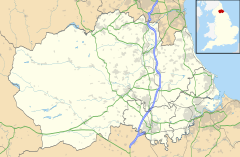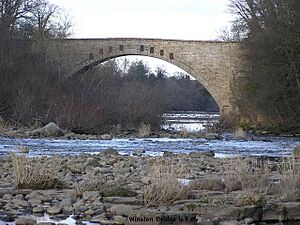Winston, County Durham facts for kids
Quick facts for kids Winston |
|
|---|---|
 A village street in Winston |
|
| Population | 431 (Including Wakerfield.2011) |
| OS grid reference | NZ140167 |
| Unitary authority | |
| Ceremonial county | |
| Region | |
| Country | England |
| Sovereign state | United Kingdom |
| Post town | Darlington |
| Postcode district | DL2 |
| Police | Durham |
| Fire | County Durham and Darlington |
| Ambulance | North East |
| EU Parliament | North East England |
| UK Parliament |
|
Winston is a small village in County Durham, England. It's about 6 miles (10 km) east of Barnard Castle. The village is located where the A67 and B6274 roads meet. In 2011, about 431 people lived there. The area around Winston also includes the small communities of Little Newsham and South Cleatlam.
Contents
A Look Back at Winston's Past
Winston has an interesting history. In the 1870s, a book called Imperial Gazetteer of England and Wales described Winston as a parish. It mentioned the village and the nearby area of Newsham. Winston was located by the River Tees and had a railway station. It also had a post office and a large bridge built in 1764.
Winston's Railway Days
Winston once had its own railway station. It opened in 1856 as part of the Darlington and Barnard Castle Railway. The station stopped taking passengers in 1964. It closed completely for freight in 1965. This was part of big changes to railways in the UK, often called the "Beeching cuts." The main station building was taken down in 2002. However, the old goods shed and the station master's house are still there today.
Coal Mining in Winston
Close to the old railway station was Westholme Colliery, which was a coal mine. At its busiest, around the start of the First World War, 87 miners worked there. The houses where these miners lived in the small area of South Cleatlam are still standing. They are now modern homes. After Westholme mine closed in 1914, two new mines opened: Teesside and North Tees. Teesside colliery closed in 1938. North Tees closed in 1966, after employing 60 men.
The Famous Winston Bridge
Winston Bridge was built over the River Tees and opened in 1763. It was used to transport coal from places like Staindrop south to Richmond. The small area of Winston Gate, on the south side of the bridge, used to have barriers and toll booths. The bridge was designed by Sir Thomas Robinson, 1st Baronet. He also designed the nearby Rokeby Hall. For a time, Winston Bridge had the longest single arch span of any bridge in Europe. It stretched 111 feet (34 meters) across the river.
In July 1988, Winston Bridge was featured in a TV show called Piece of Cake. A Spitfire plane, flown by Ray Hanna, flew under the bridge! Ray Hanna was a founding member of the RAF Red Arrows display team.
How Winston is Governed
From 1974, Winston was part of the local government area called Teesdale. This area was changed in 2009. Now, for local elections, Winston is part of the Barnard Castle East ward. This ward helps choose members for the Durham County Council.
The village is also part of the Bishop Auckland area for national elections. This area is currently represented by the Conservative Party. The person who represents Winston in the UK Parliament since 2019 is Dehenna Davison.
Community Life and Culture
Winston has an old church called St. Andrew's Church. It's a grade I listed building, which means it's very important historically. The church dates back to the 1200s, but it was greatly repaired in 1848. The village also had a Methodist chapel. It opened in 1902 and held its last service in 2016.
Winston once had a Church of England school, built in 1851. But it closed in 1961. The building was then sold and became the village's pub, which is now known as The Bridgewater Arms.
Famous People from Winston
- Thomas Wharton (anatomist), who was born on August 31, 1614, was a famous anatomist.
- Aaron Arrowsmith, a well-known map maker (cartographer), was also born here.



